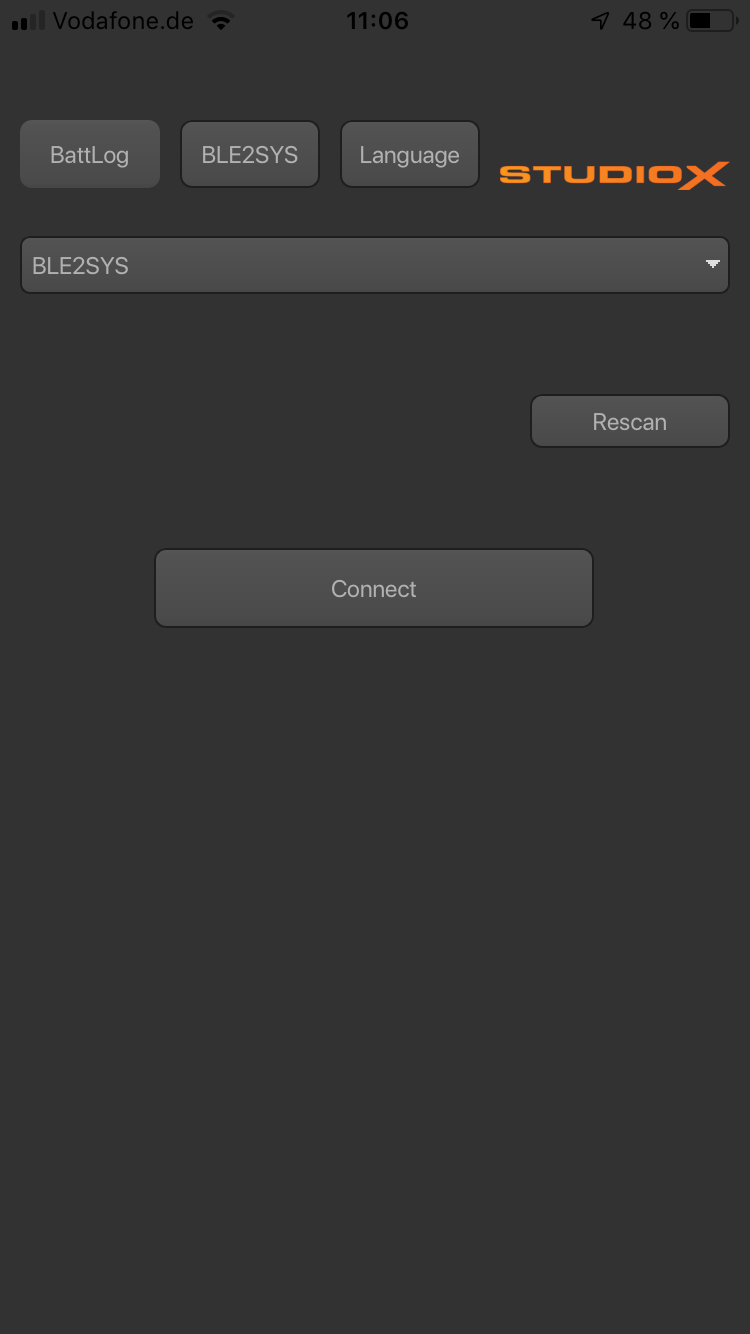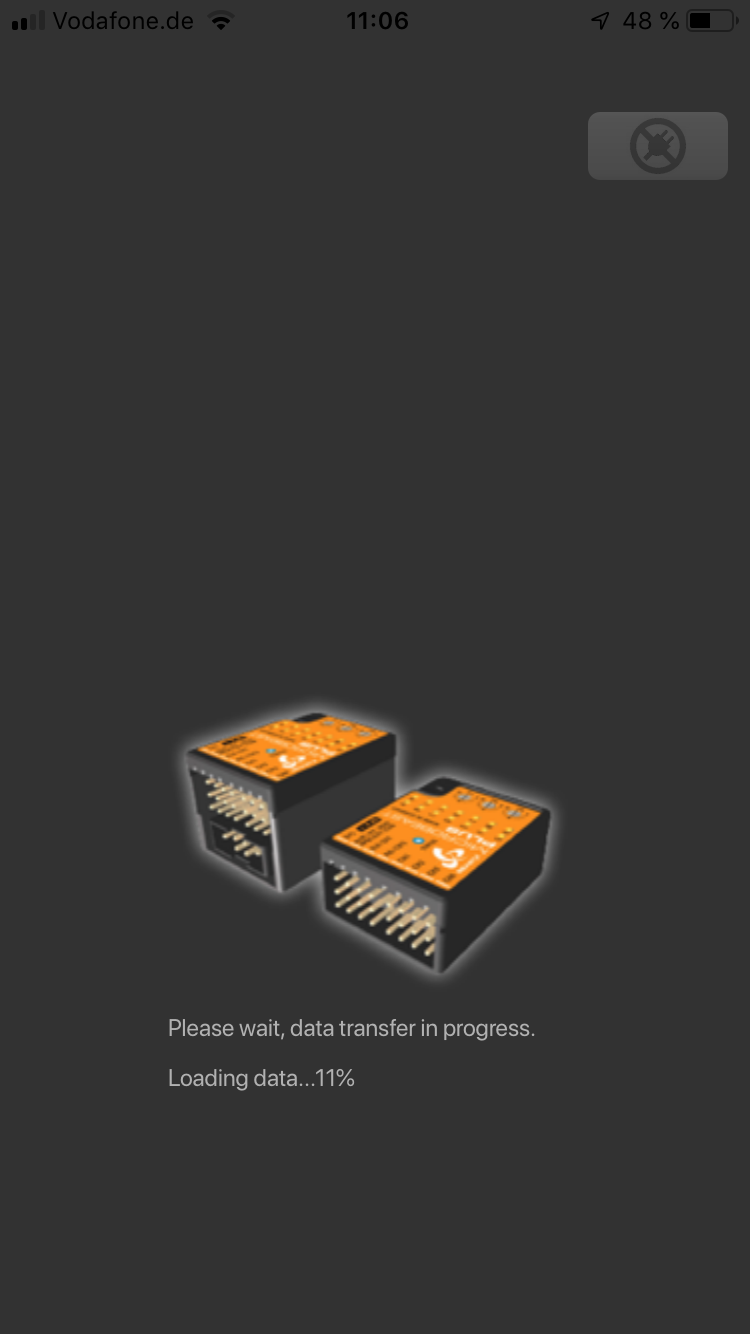Funktionsbeschreibung
BEASTX flybarless system
Connecting to device
If not already done start StudioX now. When the USB2SYS is connected to the computer, make sure the corresponding port is selected in the selection box in the middle of the screen. If you have connected it after starting the software, click the RESCAN button above to refresh the port list, usually the correct port will be selected automatically then. If you don't know which port is the right one, also you can disconnect the USB2SYS once again, click RESCAN to clear the port list, connect the USB2SYS, wait a few seconds and click RESCAN once more. Now the port should be selected.
With the BLE2SYS in combination with a smartphone/tablet the BLE2SYS device should appear automatically when starting the app after powering up your flybarless device with BLE2SYS. If this is not the case, click the selection box and choose "BLE2SYS". If nothing's there, click the RESCAN button above to search for new devices. This can take from a few seconds up to a few minutes. If the scan process finishes immediately and the box stays empty it is very likely the bluetooth function is switched off on your phone or the app has no rights to access the bluetooth connection! So check your phone settings in this case.
Then connect the USB2SYS interface to the [SYS] port of your BEASTX device and power everything up. Click CONNECT to load the data from your device and to enter configuration menus. In case you are asked for the BLE2SYS pin code, this is 1111 by default.
<img class="ios" src="
<img class="ios" src="
When connection fails, on the computer once again check driver installation and port configuration as shown in the beginning. When your BLE2SYS is not found by the smartphone/tablet, check if the BLE2SYS it is operating properly: The blue LED must flash in short intervals. Note that by default the interface will switch off automatically after 30 seconds. So if you need too long time to initiate connection it may have been disabled. Disconnect it or cylce power and try again. Sometimes it can be helpful to close the app completely, disconnect and reconnect the BLE2SYS and start over again!
Also note that the device name can be different! By default it's "BLE2SYS", but as it's possible to change the bluetooth id, it maybe different. (The automatic deactivation time as well as the bluetooth id can be changed in the configuration menu by clicking the BLE2SYS button above the device selection box.)
Overview screen
When connection to your BEASTX device is established, wait until the data is loaded from the device and initialization sequence is finished. At first the system will calibrate to the radio system, Menu LEDs H to N will cycle up and down at the device (MICROBEAST PLUS/AR7210BX) and you can read Radio init in the opening overview screen. During this time do not move the sticks on your radio as the system is learning the stick mid positions! In the second step the device checks if the sensors are working correctly and learns the sensor rest positions. Here Menu LEDs A to G will cycle up and down (MICROBEAST PLUS/AR7210BX) and you can read Sensor init in the opening overview screen. During this time do not move the helicopter! When initialization is completed, the Status LED will change to blue or purple color indicating the current gyro mode and you can read the gyro gain and mode in the app.
<img class="ios" src="
If you can't get through the initialization sequence either because LEDs A-G or LEDs H-N don't stop cycling, please read the FAQ and do the CONTROL SETUP first (see manual of your device for further instructions).
BLE2SYS Konfiguration
Tippe zum Konfigurieren des BLE2SYS Interface unter iOS/Android in der Hauptübersicht oben auf den BLE2SYS Knopf. Die Konfigurationsseite sollte dann erscheinen (ggf. wirst Du vorher noch nach der Eingabe des Pin Codes gefragt). Mit einem PC/mac lässt sich das BLE2SYS ebenfalls konfigurieren. Hierzu benötigst Du aber zusätzlich das USB2SYS Computer Interface, an das Du das BLE2SYS mittels Y-Kabel ansteckst. An die zweite Leitung musst Du dann noch eine Stromversorgung anstecken (wie zuvor schon gezeigt). Dann klickst Du in der Hauptübersicht einfach auf "Verbinden" um die Schnittstelle zu öffnen, so als würdest Du die Verbindung zu einem BEASTX Kreiselsystem herstellen.
Gerätename
Du kannst dem BLE2SYS einen beliebigen Namen geben (maximal 11 Zeichen), z. B. den Namen von Deinem Heli. Dieser Name ist dann der Bluetooth Gerätename. Bitte beachte, dass Du u. U. das BLE2SYS sowie die StudioX App neu starten musst, damit der neue Name in der Hauptübersicht sichtbar ist.
Automatische Deaktivierung
Fliege nie, wenn die Bluetooth-Verbindung aktiv ist! Das Bluetooth Signal sendet auf dem 2.4GHz Band und kann daher mit dem Signal von Deiner Fernsteuerung interferieren. Damit Du das Modul aber nicht immer abstecken musst, wenn Du es nicht verwendest, kannst Du hier einen automatischen Timeout einrichten. Wenn innerhalb der gegebenen Zeit keine Verbindung zum Modul aufgebaut wird, schaltet es sich automatisch ab. Wenn Du den Timeout auf 0 stellst wird das Modul dauerhaft aktiv sein.
Achtung: Wenn der Timeout deaktiviert ist, lasse das BLE2SYS auf keinem Fall eingesteckt, wenn Du fliegst! Dadurch könnte das Fernsteuersignal gestört werden und in Folge könnte der Heli abstürzen und zu ernsthaften Verletzungen oder Schäden führen!
Pin ändern
Falls nötig lässt sich die 4-stellige Pin für die Verbindung zum Bluetooth Modul ändern. Wir empfehlen dies unbedingt, da die Werkseinstellung "1111" jedem bekannt ist. In Folge könnte ein Fremder "Spaßvogel" versuchen, sein Smartphone mit deinem Heli zu verbinden, wenn Du auf dem Flugplatz bist oder möglicherweise sogar, wenn Du gerade fliegen willst!
Firmware Update
Wenn Du einen Computer (PC/mac) zum Konfigurieren des BLE2SYS verwendest, dann siehst Du unten zusätzlich die Schaltfläche "Firmware Update". Wenn Du darauf klickst, kannst Du offensichtlich die neusten Firmware Updates auf dein BLE2YS Interface laden. Der Updatevorgang unterscheidet sich nicht zu den anderen BEASTX Geräten. Er wird im Kapitel Firmware Update ausführlich beschrieben.